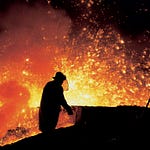This week, we zoom out to the broader intellectual themes that shaped Decouple’s origins five years ago. I’m joined by Jesse Ausubel, a visionary in sustainability and biodiversity research and the Director of the Program for the Human Environment at The Rockefeller University in New York City. In his long career, Ausubel pioneered the modern study of decarbonization and dematerialization in the late 1980s and early 1990s. He helped organize the first UN World Climate Conference in 1979 and spent the 1980s at the National Academies formulating U.S. and global climate research programs. In parallel, he has led major biodiversity initiatives including the decade-long Census of Marine Life, the DNA Barcode of Life project, and continues surveying ocean biodiversity using environmental DNA.
In this conversation, Ausubel shows how the simple framework of logistic S-curves can illuminate fundamental trends across complex systems, including energy systems. Through this lens, we discuss the “environmental trifecta” of land-sparing, decarbonization, and dematerialization, and we explore whether apparent counter-trends challenge Ausubel’s framework. Suffusing the interview is Ausubel’s belief in the wisdom of long-term thinking and objectivity: simple, insightful frameworks are a starting point for admitting much-needed complexity into our worldviews. Join us in this rare examination of the mental models that claim to predict our environmental future.
Watch now on YouTube.
We talk about
Cesare Marchetti’s contributions to energy transition theory and the concept of epidemics of epidemics
How global fuel mixes have shifted from wood to coal to oil to natural gas over centuries, chasing greater ratios of hydrogen to carbon atoms in fuel chemistry
Why the progression toward lighter fuels stalled in the 1970s and what that reveals about energy policy
The dematerialization question: analyzing 100 commodities in America over 120 years
Chickens as the unexpected winner in protein production and what that means for land and water use
China’s Inner Mongolia energy bases and whether they contradict the power density thesis
Differing views of systems change: inevitability versus conscious human influence
Trends that have surprised Ausubel over his career
Checking in on the long view
Having built this podcast around concepts like decoupling human prosperity from environmental impact, I’ve still often entertained doubts about humanity’s ability to achieve decoupling at scale. Evidence abounds that seems to counter elegant, techno-optimist theories like the inevitable climb up the “energy density ladder.” While I had Jesse Ausubel on the line, I aimed to test his theories about the “environmental trifecta” — humanity’s trend toward decarbonization, land sparing, and dematerialization — with potential counterexamples from the real world. After all, Ausubel himself says theories, without data, are dry toast.
A heavy influence on Ausubel’s thinking was his mentor and collaborator Cesare Marchetti (1927–2023). Though far from a household name, Marchetti left a reverberating impact on systems thinking about energy, climate, and the environment. A key contribution was his efforts to empirically plot the evolution of biological and technological systems along logistic S-curves. To him, this practice revealed that progress across domains arises from an “epidemic of epidemics,” with waves of diffusion and adoption that rise, crest, and fade. For energy systems, one metric he plotted was the ratio of carbon atoms to hydrogen atoms in humanity’s fuel choices. This revealed a long trend: as we moved from wood to coal to oil to methane, the chemical makeup of these fuels shifted to fewer carbon atoms per hydrogen atom. The logical end result was that humanity would eventually decarbonize by using pure hydrogen fuels, requiring massive amounts of solar and nuclear energy to produce.

But the march toward greater proportions of hydrogen in global energy use slowed in the 1970s. Ausubel, a direct mentee of Marchetti who worked closely with him for years, still believes in the eventual reign of hydrogen, defending the long view that these trends will withstand temporary setbacks. The setbacks he notes include the heavier hand of energy policy that descended in the 1970s, causing newly self-aware heavy fossil fuel industries (like coal and oil) to strive to retain market share amid the rise of methane (natural gas) and alternative energy sources. He acknowledges the counterargument that hydrogen, for a host of engineering and economic reasons, has failed to take off as a widespread energy carrier despite established processes for its production. But these, he argues, are challenges to work through. The logistic curve of technological adoption can take longer than any but the most patient people would like.
On the question of land sparing and energy density, to which humans should theoretically be progressing in an S-curve fashion, I point to China’s planned clean energy bases in Inner Mongolia. These installations will be utterly sprawling, each with around 8 GW of solar, 4 GW of wind, and 4 GW of “supporting coal” connected via ultra-high-voltage transmission lines to distant load centers. Does this contradict the idea that energy systems trend toward denser fuels? Ausubel argues it doesn’t. To him, urbanization and the intensification of energy consumption on the demand side continue undeterred. Ever-increasing energy density on the supply side has simply been a corollary to that. From the end-user perspective, these energy bases satisfy energy density requirements, just while exploiting the abundant land available in more remote locations.
To Ausubel, the biggest question mark hangs over dematerialization. By dematerialization, he means the tendency for GDP to decouple from material consumption, shedding its historical collinearity. He shares the results of his “chickens and gallium” study, where he and co-authors tracked American consumption in 100 commodities over 120 years. Of the hundred, only about a dozen “materialized” in America (rose both in absolute terms and relative to GDP, indicating growing economic dependence on its materiality). The stand-out example is broiler chickens, which have become a massively efficient protein generator compared to cows and pigs, and are now the most popular meat in America. Yet I question the study’s focus on America. Is America’s dematerialization real, or is it an illusion of offshoring?
We discuss these and more questions with the brilliant Ausubel in the full episode.
Watch Jesse Ausubel’s talk at the 2024 Breakthrough Dialogue:
Support Decouple
If you enjoy our work, consider making a pledge on Substack or a tax-deductible donation through our fiscal sponsor.









